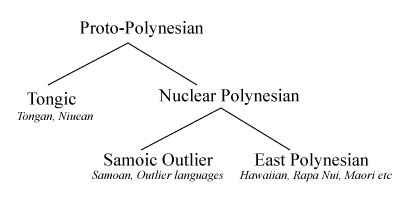This article needs additional citations for verification .(August 2022) |
| Nuclear Polynesian | |
|---|---|
| Geographic distribution | Polynesia |
| Linguistic classification | Austronesian
|
| Subdivisions | |
| Language codes | |
| Glottolog | nucl1485 |

Nuclear Polynesian refers to those languages comprising the Samoic and the Eastern Polynesian branches of the Polynesian group of Austronesian languages.
Contents
The Eastern Polynesian group comprises two major subgroups: Rapa Nui, spoken on Easter Island, and Central-Eastern, which is itself composed of Rapan, and the Marquesic and Tahitic languages.
Nuclear Polynesian is differentiated, among Polynesian languages, by its distinguishing characteristics from the Tongic languages spoken in most of Tonga and in Niue.